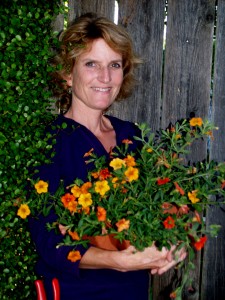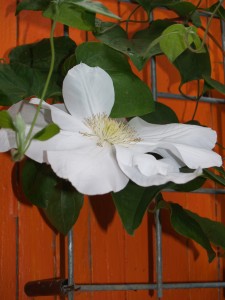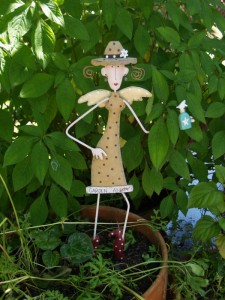CALIFORNIA Santa Rosa – Mary Frost keeps a list of sure-fire ways gardeners sabotage success in their home gardens.
At the top is the notion that an entire landscaping project must be done at once. “Successful gardens evolve over time, even years,” the Santa Rosa resident says.
 Another is to act impulsively, dropping by a nursery and buying plants because they look pretty with no thought to eventual size or where they might go.
Another is to act impulsively, dropping by a nursery and buying plants because they look pretty with no thought to eventual size or where they might go.
“Other sabotage practices begin in the head,” she adds, “such as, ‘I’m afraid I’m not going to do it right’ or “I don’t have the time.”
Mary’s list comes from what well might be a one-of-a-kind business that she invented for herself– Gardening Tutor .
“I’m not a landscape contractor, not a designer,” she says. “Those who contact me are do-it-yourselfers needing a bit of help. Some are afraid of making mistakes, others are time crunched or don’t know where to start. We work together hands on, side-by side. We may shop for plants, decide on a maintenance plan. As the gardening tutor, I assist in whatever it takes so that the garden they create makes them happy.”
Mary’s expertise comes from her own garden begun 15 years ago when she and her husband Jack Frost, a cement contractor, purchased a 1920’s fixer-up cottage in Santa Rosa’s Roseland district. Mary, then a deep-tissue massage therapist, thought her clients might enjoy a small, tranquil garden where they might relax before and after treatments. It was her first foray into gardening.
“I had no idea of what I was doing,” she says. “I just stuck things in here and there. Sunflowers, alyssum, ferns, a flamboyant hibiscus. It looked like it had a plan, but it didn’t.”
When work-related injuries made it necessary to discontinue her massage business, Mary began to garden areas around the cottage in earnest, eventually earning an associate’s degree in landscape management from Santa Rosa Junior College.
“After graduating, I didn’t know what direction to go,” she says. “But I was always noticing other people’s gardens. Often I’d think, ‘Whoever owns that one could use a little tutoring.’ One day, I was helping a friend shop for mulch. As she drove away with bags tucked into the trunk of her car, she yelled out the window, ‘You should do this for a living!’ I came home, sat down, wrote a business plan and became the Gardening Tutor.”
The garden surrounding the Frost’s cottage had turned into a neighborhood show stopper – perfect for Mary to use as a demonstration garden. In it she not only points out why she feels certain areas are successful but also mistakes that she’s learned to live with, like the magnolia planted too close to the house. If an errant weed is here or there, so be it. “My purpose is to inspire, not intimidate,” she says.
 A concrete walk, courtesy of Jack, wanders off to the south side of the house where, on one side, a rambunctiously colorful “English style” garden thrives in the sun, ending with a white Marie Boisselot clematis clinging to a hog wire trellis on a bright orange fence.
A concrete walk, courtesy of Jack, wanders off to the south side of the house where, on one side, a rambunctiously colorful “English style” garden thrives in the sun, ending with a white Marie Boisselot clematis clinging to a hog wire trellis on a bright orange fence.
Directly opposite in the shade, four plants – a delicate Japanese maple, a clambering jasmine in the background, the yellow-green needles of Japanese sweet flag along with blue-flowering vinca minor as ground cover – create a garden of serenity. “I ask my clients, ‘Which do you like best? Which makes you feel happiest?”
In front of the cottage, a curving path covered in wood chips separates small garden areas. Annuals and perennials are mixed with abandon. Tall clumps of deep-red papaver Dream Queen, spikes of blue larkspur, verbascum’s towering, furry, gray-green leaves provoke discussion about the importance of vertical accents.
She points out the fun of garden “jewelry,” garden art placed judiciously here and there. Blue “star balls” spheres rest in a bed of baby tears; a tin garden angel claims a spot in a porch pot.
Most special to her is “Tea for Two” – a red-painted bistro set topped with two teacups and attached to the fence with pink clematis winding through – a memorial to her sister Amelia.
“I remember well what it’s like to be a new gardener,” she says. “I try not to use the word ‘mistake’ and instead encourage practices that don’t sabotage success.”
Santa Rosan Michele Brulé felt she had already too much on her plate without adding the garden to her list. Taking a deep breath, she called the Gardening Tutor. “Quickly I found out that gardening doesn’t have to be hard, frustrating, and expensive,” she says.
“Mary comes to our home and we work together, make field trips to nurseries. It’s fun! Along the way I’ve gained a great education on plants, insects, soil, fertilizer and everything in between.”
Satisfying to the Gardening Tutor is that Michele Brulé and her husband now have a garden that makes them happy.
 As for her own garden, Mary is pleased when it elicits a smile from a passer-by over the weathered-wood picket fence. Even more so when someone takes a moment to stop and say, “Your garden is beautiful.”
As for her own garden, Mary is pleased when it elicits a smile from a passer-by over the weathered-wood picket fence. Even more so when someone takes a moment to stop and say, “Your garden is beautiful.”
TIPS FROM THE GARDENING TUTOR:
When preparing a pot for planting, consider that the soil will pack down. Fill it super full.
Pieces of ornamental art add fun and interest. Use them judiciously and change them around.
Listen to the designer in you. If it says, that space needs something purple. Go for it. Don’t be afraid of doing something wrong.
Know your plants. For instance, some will take over the space if watered more, while a little spray will keep them fresh and within bounds.
Vertical plants are wonderful for small gardens, creating extra space by taking the eye up.
Add contrast with the addition of plants with big leaves.
No one should be without Sunset’s Western Garden Book.
Contact the Gardening Tutor: Telephone: 707 545-6863; www.TheGardeningTutor.net


